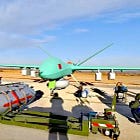Commentary-themed posts are intended to highlight a specific issue, not limited to recent and ongoing events. These posts will typically be much shorter and less detailed than my analysis-themed posts.
For years, many analyses on how a major war between China and the United States would play out assumed that the People’s Liberation Army (PLA) in general and the Second Artillery Corps (SAC) turned PLA Rocket Force (PLARF) in particular would, in effect, undertake a conventional first strike against American military bases in Japan and perhaps Japanese military bases as well. Over the past decade or so, there have been growing indications that China’s decision-makers—perhaps not PLA planners—want to retain options in times of crisis and war instead of being forced to make such fateful decisions at the outset or in advance of a conflict. The PLA is increasingly well-positioned to wage war against Taiwan while retaining sufficient capabilities to also wage war against the United States and Japan in a manner that increasingly shifts the onus of making such fateful choices to Washington and Tokyo. None of this, however, necessarily means that the PLA in general and the PLARF in particular will limit any conventional first strike to Taiwan itself or that there is not another country that may be targeted alongside the United States in a more expansive conflict scenario other than Japan.
While Japan remains critically important to American military planning, there has been an important development underway over the past five or so years: the increasingly important role that the Philippines—the country’s geographical position and real estate, not its current military or industrial capabilities—is likely to play in a major conflict between China and the United States, particularly a protracted conflict scenario. The Philippines is a treaty ally of the United States. Attacking the Philippines will, as such, likely bring the United States into a war with China even if China wages a war against Taiwan without targeting American military forces in Japan or the American island territory of Guam. Observers need to be mindful of the possibility that a major conflict scenario, the most likely cause of which is a zero-sum cross-strait crisis over the fate of Taiwan, may result in immediate American intervention but perhaps delayed Japanese intervention, provided, of course, that China does not bring Japan into the war by undertaking something in the vein of a conventional first strike against American military forces in Japan and perhaps Japanese military bases as well. In such a scenario, Chinese decision-makers will need to decide whether they will attack the Philippines first or if they will wait for the Philippines to formally enter the war or, more generally, for American military forces operating on Philippine territory to first attack the Chinese mainland and/or Chinese aircraft and warships in the vicinity of the Philippines.
In a recent post, I discussed the implications of China’s increasing electrification on wartime military dynamics to broach the important role that Chinese attacks on third parties, namely Japan and the Philippines, are likely to play in a major war, particularly a protracted war, between China and the United States:
Perhaps the biggest military challenge that China faces vis-a-vis the United States is that large-scale strikes targeting the continental United States, excluding Alaska, are an extremely difficult undertaking as a result of the immense distances that separate the two countries. As a result, the most practical way for China to deter and, failing that, retaliate against attacks on its electricity generation and transmission infrastructure is to carry out like-for-like, tit-for-tat strikes on the electricity generation and transmission infrastructure of more proximate adversaries, which is to say Japan and the Philippines—for Beijing, retaliating against Taiwan for attacks undertaken by the United States, as opposed to attacks undertaken by Taiwan itself, essentially amount to acts of self-harm. In other words, China’s response to the target of electricity generation and transmission infrastructure in the Yangtze River Delta (i.e., Shanghai and its environs) would be to target electricity generation and transmission infrastructure in, for example, the Kanto Plain (i.e., Tokyo and its environs).
Whereas Japan has a large and well-equipped military that is starting to deploy long-range strike capabilities of its own, the Philippines—a sprawling archipelagic country—is at present and for the foreseeable future fully exposed to China’s long-range strike capabilities. The Philippines is, as such, a far more enticing, albeit less lucrative, target for a Chinese first-strike than Japan. Targeting the Philippines in a series of devastating opening salvos—which will likely have to attack Philippine infrastructure and dual-use facilities in the absence of many high-value military targets—will allow Chinese decision-makers to display resolve and, more to the point, the consequences that will arise for other countries that join forces with the United States against China and, more generally, facilitate American military operations against China by providing access to ports and airports, acquiescing to uncontested overflights by American military aircraft and munitions—as well as the likes of Australian military aircraft and munitions, and so forth. I am inclined to think that one of the most important lessons of the Russia-Ukraine War for China is the imperative of deterring foreign intervention in a cross-strait conflict, one that is, I think, likely to play out as a protracted multi-month, if not multi-year, war, no matter how much Chinese decision-makers, among others, may strive to avoid such a scenario.
It bears emphasis that the American military currently appears to primarily view the Philippines archipelago as a forward basing node for long-range strike capabilities and intelligence, surveillance, and reconnaissance capabilities. While airbases and airports across the Philippines may come to host small detachments of American military aircraft under operational concepts such as Agile Combat Employment (ACE) and similar, there are currently no plans to establish in the Philippines analogues to the sprawling American airbases in Japan—the likes of Kadena, Iwakuni, and Misawa. The scope for purely counterforce—targeting only military capabilities—Chinese strikes against the Philippines is, as such, far more limited than is the case against Japan, and Chinese strikes against the Philippines are, as such, likely to be more counter-value, cost-imposing, and punitive in nature. Targeting energy storage and transportation infrastructure and marine transportation—inherently dual-use targets—in the Philippines will likely be one of the most effective ways to degrade the value of the archipelagic country as a forward-basing node for the American military and may possibly drive Manila to throw in the towel and seek to an end to its role in a major war between China and the United States.
This post is intended to further broach an overlooked topic that I have touched upon in several of my recent posts: the qualitative and quantitative limitations of China’s long-range strike capabilities to attack distant targets beyond Taiwan, Japan’s Ryukyu Islands, and the American island territory of Guam.
With respect to China’s ability to undertake symmetrical tit-for-tat strikes on electricity generation and transmission facilities located in Japan and the Philippines, which will always be far more practical targets for Chinese strike munitions than comparable facilities in the continental United States, I wrote the following:
As things stand, the Chinese military is not ready to undertake such attacks on a sustained basis, at least not while also attacking purely military targets across the Indo-Pacific in a major conflict scenario. This may, however, change in the coming years in a context in which the United States is leading the way in expanding its strike munition arsenal so as to attack a far greater number of targets across the Chinese mainland—China may emulate this American approach if it has not done so already.
While the Philippines is an increasingly enticing target for a Chinese first strike, publicly available information does not indicate that the PLA is either equipped or trained to carry out sustained large-scale strikes across the Philippines, at least not while also attacking purely military targets across the Indo-Pacific in a major conflict scenario. Unless and until this changes, with the capacity to undertake sustained large-scale attacks also serving as a proxy for China’s ability to prosecute a war that involves third-party intervention beyond the United States and Japan, there is a case to be made that China’s sealift capacity, its maritime strike capabilities, and similar widely discussed issues are likely to be overridden in importance by the ability of countries that are not named China to determine Beijing’s viable war termination options irrespective of how much of the island of Taiwan may end up under the occupation of PLA forces. Stated differently, China’s ability to sustain large-scale attacks against a wide range of targets across the Philippines, among other countries, is of increasing analytical importance to anyone interested in the fast-evolving military balance in the Indo-Pacific.






